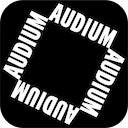Western Edition
Serving the Heart of San Francisco
Volume 2, Number 9 August 1995
A ‘sound’ experience
by Richard Fitzpatrick
“If there’s an underground, we’re beneath that,” says Stan Shaff in reference to his and Doug McEachern’s musical innovation. Both men are composers and the architects of Audium 8, a musical show that has managed to harness the primal essence of sound. It is an evening of sensuality, punctuated by points of disturbances. It could be to sound what virtual reality is to sight.
The program note recommends you “bring your ears and your imagination.”
The partners perform twice weekly in a nondescript complex at Bush and Franklin streets. Meander in at about 8 p. m. It has the feel of entering Vincent Price’s House of Wax — the first of many subconscious images triggered by the locale. Self-service coffee is an option while you roam around an L-shaped foyer, sculptured surrealistically with potted chairs, mysterious wood carvings and dadaistic paintings — items deviously placed to attune the psyche for the musical carnival that awaits. Already a cluster of sounds whistle through the air: an organ rises gently to a pitch, a clock ticks infuriatingly, grasshoppers transport you.
Almost imperceptibly you’ll feel yourself drawn into the Audium through a maze-like passageway. The dome-shaped room is frenetically peopled with diverse mechanical shapes, shaded from black through gray to white. Seating for 49 is arranged in three concentric circles around the grounded apex of the room. Carefully camouflaged are 169 speakers. Master Shaff unnoticeably seats himself at the mixer. He cuts an ambivalent shape at the pulpit, a demagogue of equivocal persuasion. The lights dim to pitchy darkness.
Just after an hour later you’ll emerge uncertain, excitable, outside of yourself. An attempt to chronicle the experience seems fatuous; it is a most remarkable inner journey.
Ostensibly one sits in darkness while a cacophony of sound vibrates around a theater; waves bouncing over, beneath and through you. The sounds range from primitive clinks to quasi-electric clanks. Trains rush through, children chatter, arch angels drum softly on organs. While these noises beam around the sculptured air, one’s eyes hopelessly scurry after them.
At one stage, I am swaying gently in my chair, or is that my mother’s arms. My mind races into tunnels after a sound. Sometimes in might not reappear for minutes, having grasped a fantasy or private image. The range of emotions are all touched on. At various stages my cheeks purse in a smile, later I am bordering on tears. Indescribable, a waking dream.
After the performance, Shaff’s dulcet voice is a necessary antidote to the dizzy chaos in my head. He answers carefully the eager inquiries from the audience. Why is there no promotion for the event?
In keeping with Shaff’s unassuming nature, Audium is low-key. Word of mouth seems to be the box office mainstay. The man beside me had “wandered in somehow.” Nor is there any merchandising. Amazingly Shaff records the sounds from methods as diverse as tinkering with state-of-the-art sound equipment to roaming playgrounds and street corners with a tape recorder.
Shaff is a classically trained musician, specifically in the brass field. McEachern’s discipline is in electronics and equipment design. Both are music teachers. Shaff was interested in exploring the rudiments of space and sound. He wanted to investigate the environment that produced the music of Neanderthal man “yelling across canyons” — the idea that sound can travel from different points simultaneously. The landscape of sound is truly metaphysical, as opposed to the visual world, which is three-dimensional and seemingly more accessible.
Sound, if placed in the right context, will stimulate emotional properties. Shaff explains that he has “always been possessed by the evocative qualities all sounds seem to have, whether natural or electronic. Sounds touch deeper levels of our inner life, layers that lie just beneath the visual world.” It is the kernel truth of Audium that it is an emotional experience rather than an intellectual exercise, aesthetics rather than physics. Audium provides the canvas to communicate this.
Shaff and McEachern have been exploring sound since the late 1950’s. The initial Audium symphonies were conducted in various centers around San Francisco before they opened the current and definitive Western Addition venue in 1975.
A grant from the National Endowment for the Arts was once allotted. However governmental funding has long since dissipated.
Despite this, an Audium 9 is in the works. Media attention to Audium has been continuous but relatively peripheral. Interest from peers is mixed, from naked admiration to guarded indifference.
No one seems to be able to really quantify the production.
It has a fin de siecle feel about it. One senses it is a dormant wing of the media hurricane sweeping our world, the future of music, an auditory development that blends antithetical sounds from the beginning of the world to the end of the world.
